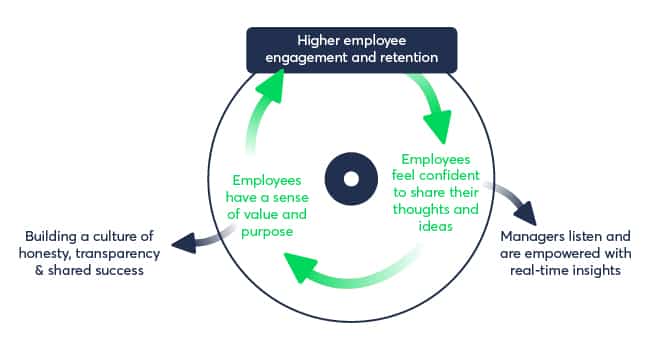Employee engagement has been a top focus for companies worldwide over the past few years, and 2019 will be no different. Directly linked to business productivity, customer satisfaction, and employer branding, your employee engagement strategy has a far-reaching impact on the success of your business.
Providing teams with good pay, benefits and a ping-pong table is no longer enough – to win the employee engagement game, companies need to keep up with the rapid pace of new technologies and the changing demands of a young workforce.
Read on to discover Zest’s list of the 2019 Employee Engagement Trends that forward-thinking companies are adopting in the year to come and decide for yourself which are fleeting, and which are here to stay.
Work Flexibility
Flexible hours, remote working, working from home… no matter your route, creating a culture where work fits in with life is the first on our list of 2019 Employee Engagement Trends. It’s not a new concept, but with Millennials now representing the majority of the workforce, and Generation Z beginning to appear on the professional scene, flexibility around when and where collaborators work is more than just a desire, it’s a demand.
In a recent survey by Intuit, 76% of respondents say that a flexible work schedule is the best incentive their employer could offer (Source: Intuit) and has a positive effect on productivity (Source: People XCD). More than pay and benefits, modern collaborators (namely Millennials) are looking for a job which compliments their lifestyle. Doctors appointment, dance class, charity work… it’s important to millennials that they can do it all. And why should it matter where? Whether it’s from home to look after sick children or in another city to be close to a customer, when comparing productivity, performance or position, location is the least important factor.
In a recent survey by Intuit, 76% of respondents say that a flexible work schedule is the best incentive their employer could offer and has a positive effect on productivity.
But that doesn’t mean a compromise on professional work ethic. In fact, Millennials, and their even harder to please counterparts Gen Z, will show greater commitment to a company that values them in return. Companies who embrace, and even encourage, a culture of work-life flexibility will in turn see employee engagement increase, productivity soar, and will ultimately win the talent, and retention, war.
What about teamwork? Partly due to the rise in affordable and easy-to-use digital collaborative tools, our highly connected, always-on world means it’s no longer necessary to be bound be physical location. Many collaborative solutions, like Zest, support distance working. Combining Slackfor informal communication, Asanafor task management, AirTablefor project collaboration and the hundreds of others in-between, teamwork in the digital world is arguably stronger when we’re physically remote.
Continuous Feedback
Beyond where we physically work, a focus on howwe work is just as important. Long gone are the once-per-year performance appraisals or annual corporate surveys. Conversations based on performance from twelve months ago are bound to be dishonest (especially if it concludes in a pay rise), blurred by fading memory or, more likely, only reflecting the most recent few weeks. On top of that, the amount of admin time to prepare, consolidate and analyze such conversations almost isn’t worth the outdated information it’s going to produce.
To get a true holistic view of performance, from both an individual and company-wide perspective, companies need to welcome a modern style of communication into their office: say hello to the second on our list of 2019 Employee Engagement Trends: continuous feedback.
In a desire to learn, improve and reaffirm their actions, collaborators crave continuous feedback. In fact, 60% of employees desire feedback on a daily or weekly basis (Source: LinkedIn). Leading companies are creating cultures based around continuous feedback, which is by definition frequent and in real-time, to easily and continuously gauge levels of employee engagement, monitor performance, and resolve issues.
But feedback shouldn’t just be for the benefit of manager; it’s more important and insightful for companies to focus on peer-to-peer and collaborator-to-manager feedback. Those accepting, and encouraging, a culture of bottom-up communication will receive invaluable employee insights, unrivaled through annual performance reviews or yearly surveys. When freely given, feedback is honest, unbarred and, hopefully, actionable.
Whilst continuous feedback is, by definition, on-going and often unplanned, it’s also important not to miss critical scheduled moments. Companies actively surveying collaborators at key periods, such as after on-boarding, post-trial period, or when returning from leave, show a stronger sense of care to their employees’ wellbeing, who we know value such gestures and will reciprocate them.
Also bolstered by the explosion of collaborative tools and technologies on the market, companies who solicit, track and provide personalized feedback, continuously and in real-time, are creating cultures built upon honesty, transparency and shared-success. Continuous feedback works like a virtuous cycle of action: employees feel empowered to share their ideas and thoughts –> the perceived action of sharing their opinion gives collaborators a sense of purpose and value –> purpose and value lead to higher engagement, performance and retention.
Virtuous Cycle of Continuous Feedback

By simply giving your teams the tools to have a voice, you’ll find yourself listening intensely.
Health and Wellness
More than just employee ‘happiness’, front-running companies in 2019 understand the impact of health and wellness on the wider employee engagement spectrum. With more than $2billion being invested in the wellbeing market in the past two years (Source: Keka) and an estimated growth at a CAGR of 5.5% by 2022 (Source: PR Newswire), the value of holistic health and wellness programs has shifted from an reactive measure to an upfront necessity.
From financial planning to nutrition advice, companies with strong physical and mental wellbeing programs in place are spearheading the third of our 2019 Employee Engagement Trends: health and wellness.
Today’s highly competitive labor market means good news for the employee and bad news for the employer. Good pay and nice benefits are no longer enough. Ten-fold that thought when speaking about Millennials. To stand out, companies are shifting their focus to the emotional and psychosocial forces that underpin employee engagement.
Good pay and nice benefits are no longer enough. To stand out, companies are shifting their focus to the emotional and psychosocial forces that underpin employee engagement.
But it’s not really a surprise, the benefits of health and wellness are engrained in us since we’re in preschool. Companies offering gym memberships or walking meetings have physically healthier employees. Those providing financial guidance or counselling have teams with clearer minds to focus on their job at hand. Implementing programs aimed to improve employee health and wellness results in teams who are less stressed and take fewer sick days. Fewer sick days mean less money lost to absenteeism, burn out, and possibility resignation. Happier, healthier, mentally stable employees are more productive, engaged and motivated.
And there’s strong benefits to teamwork, too. Participating in group fitness challenges or collectively attending a nutrition workshop foster teamwork and workplace camaraderie. Furthermore, individual wellbeing is an essential building block for creating engaged, high-performing teams. With health and wellbeing having a direct correlation with employees’ productivity and performance levels, companies wanting to attract and retain top talent, need to promote, and invest in, a healthy workplace.
Predictive Analytics
As we enter the 4th Industrial Revolution, terms such as ‘AI’ and ‘Machine Learning’ are becoming everyday lingo. But the application of such technologies into the realm of Employee Engagement has, until recently, been limited. 2019 is set to change that. Poised to really take off this year, the potential of Predictive Analytics in HR, the fourth of our 2019 Employee Engagement Trends, is causing the tech to cross over into previously unchartered territory.
Analytics and AI have the ability to revolutionize every aspect of HR (Source: Human Resources Today). Previously, genuine employee engagement was difficult to measure. Solutions did a great job at gathering insights and delivering information, but beyond that was wishful thinking. With 84% of executives considering ‘people analytics’ (predications in human actions based on AI) to be a high priority for their organizations (Source: Deloitte), 2019 will see the convergence of predictive analysis into the realm of employee engagement become a reality.
Predictive analytics is simply using data to make predictions. With the mass of big data at our fingertips and sophisticated analytics tools to digest this previously disparate data into patterns and meaning, predictive analytics takes the guesswork out of employee engagement. Through machine learning, patterns in behavior are identified and trends are predicted.
With 84% of executives considering ‘people analytics’ to be a high priority for their organizations, 2019 will see the convergence of predictive analysis into the realm of employee engagement become a reality.
It’s good news for managers – armed with data-backed analytical insights and predicted trends, they can comfortably (and accurately) make decisions, in real-time, based on hard data rather than gut instinct. From measuring, tracking and understanding employee behavior, to making informed decisions or proposing new initiatives, predictive analytics are the driving force behind boosting employee performance.
Welcome the future, where anticipating when an employee is going to quit, minimizing breakdowns, or predicting moments of hardship can be crunched by numbers. Companies investing in employee engagement solutions powered by predictive analytics will find themselves saving money on retention, avoiding episodes of stress, and benefiting from increased employee engagement, all via data-driven insights from a few (billion) numbers.
Career Development
Seeking a position that enables continuous learning is the reason why 44% of employees choose their current job (Source: Bonus), and why career development makes our list of 2019 Employee Engagement Trends. In a drive to progressively shape their career, today’s employees strive for continuous professional growth and improvement, and value companies who share that vision.
Providing on-demand, personalized learning opportunities in the form of online courses, goal and skill development, or digital training programs is a win-win for both companies and employees. Employees who are constantly learning are less likely to get bored and feel stagnant in their role. Change, growth and learning new things are conducive to heightened employee engagement and improved performance.
Providing on-demand, personalized learning opportunities in the form of online courses, goal and skill development, or digital training programs is a win-win for both companies and employees.
Continuous learning develops the skills needed for an employee to do their current, and any future, job at the highest possible standard. Companies putting a focus on career development evoke a sense of shared investment in an employees’ future, fostering loyalty and reducing turnover.
But the importance of career development is more than just avoiding boredom or reducing turnover. Reflected in our rapidly evolving world, the 4th Industrial Revolution and non-stop digital developments present huge opportunities, and threats, to employees. As the jobs of the future jobs demand skills to match, companies must upskill their workers or risk playing a game of constant catchup.
This, coupled with an impending transfer in management (Millennials are poised to take over the majority of leadership and decision-making roles within the next two decades), today’s companies have a duty to prepare both the workforce, and the businesses they will lead, for future success.
In today’s labor market, employees expect a wide range of growth and development opportunities to equip them for any and all future challenges they may face. 2019 will favor companies who empower employees to manage their career development through continuous learning. But, it’s good news for companies: the intellectual outputs from an investment in human capital are highly skilled workers, effective teams and business innovation. And what company wouldn’t strive for such benefits.




